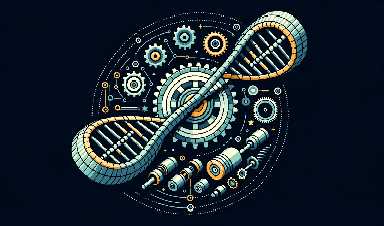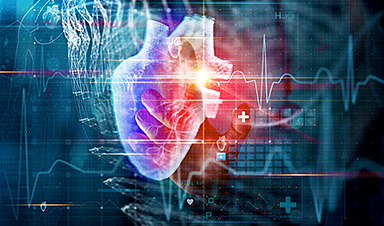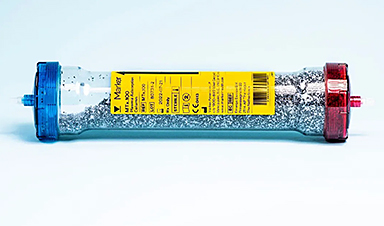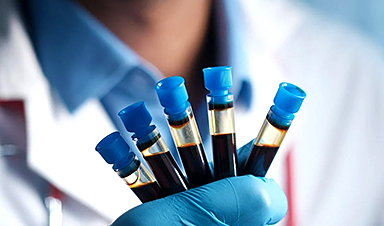An international team of scientists has recently developed a novel type of nano engine made of DNA. It is driven by a clever mechanism and can perform pulsing movements. The researchers are now planning to fit it with a coupling and install it as a drive in complex nano machines. Their results have been published in the journal Nature Nanotechnology.
Šulc has used his group’s computer modeling tools to gain insights into design and operation of this leaf-spring nano engine. The structure is comprised of almost 14,000 nucleotides, which form the basic structural units of DNA.
“Being able to simulate motion in such a large nanostructure would be impossible without oxDNA, the computer model that our group uses for design and design of DNA nanostructures,” explains Šulc. “It is the first time that a chemically powered DNA nanotechnology motor has been successfully engineered. We are very excited that our research methods could help with studying it, and are looking forward to building even more complex nanodevices in the future.”
This novel type of engine is similar to a hand grip strength trainer that strengthens your grip when used regularly. However, the motor is around one million times smaller. Two handles are connected by a spring in a V-shaped structure.
In a hand grip strength trainer, you squeeze the handles together against the resistance of the spring. Once you release your grip, the spring pushes the handles back to their original position. “Our motor uses a very similar principle,” says professor Michael Famulok from the Life and Medical Sciences (LIMES) Institute at the University of Bonn. “But the handles are not pressed together but rather pulled together.”
The researchers have repurposed a mechanism without which there would be no plants or animals on Earth. Every cell is equipped with a sort of library. It contains the blueprints for all types of proteins that each cell needs to perform its function. If the cell wants to produce a certain type of protein, it orders a copy from the respective blueprint. This transcript is produced by the enzymes called RNA polymerases.
RNA polymerases drive the pulsing movements
The original blueprint consists of long strands of DNA. The RNA polymerases move along these strands and copy the stored information letter by letter.
“We took an RNA polymerase and attached it to one of the handles in our nanomachine,” explains Famulok, who is also a member of the transdisciplinary research areas “Life & Health” and “Matter” at the University of Bonn.
“In close proximity, we also strained a DNA strand between the two handles. The polymerase grabs on to this strand to copy it. It pulls itself along the strand and the non-transcribed section becomes increasingly smaller. This pulls the second handle bit by bit towards the first one, compressing the spring at the same time.”
The DNA strand between the handles contains a particular sequence of letters shortly before its end. This so-called termination sequence signals to the polymerase that it should let go of the DNA. The spring can now relax again and moves the handles apart. This brings the start sequence of the strand close to the polymerase and the molecular copier can start a new transcription process: The cycle then repeats.
“In this way, our nanomotor performs a pulsing action,” explains Mathias Centola from the research group headed by professor Famulok, who carried out a large proportion of the experiments.
An alphabet soup serves as fuel
This motor also needs energy just like any other type of motor. It is provided by the “alphabet soup” from which the polymerase produces the transcripts. Every one of these letters (in technical terminology: nucleotides) has a small tail consisting of three phosphate groups—a triphosphate.
In order to attach a new letter to an existing sentence, the polymerase has to remove two of these phosphate groups. This releases energy which it can use for linking the letters together. “Our motor thus uses nucleotide triphosphates as fuel,” says Famulok. “It can only continue to run when a sufficient number of them are available.”
The researchers were able to demonstrate that the motor can be easily combined with other structures. This should make it possible for it to, for example, wander across a surface—similar to an inchworm that pulls itself along a branch in its own characteristic style.
“We are also planning to produce a type of clutch that will allow us to only utilize the power of the motor at certain times and otherwise leave it to idle,” explains Famulok. In the long term, the motor could become the heart of a complex nanomachine. “However, there is still a lot of work to be done before we reach this stage.”
Šulc’s lab is highly interdisciplinary and applies broadly the methods of statistical physics and computational modeling to problems in chemistry, biology and nanotechnology. The group develops new multiscale models to study interactions between biomolecules, particularly in the context of design and simulations of DNA and RNA nanostructures and devices.
“Just as complex machines in our everyday use—planes, cars and chips in electronics—require sophisticated computer-aided design tools to make sure they perform a desired function, there is a pressing need to have access to such methods in the molecular sciences.”
Professor Tijana Rajh, director of the School of Molecular Sciences, said, “Petr Šulc and his group are doing extremely innovative molecular science, using the methods of computational chemistry and physics to study DNA and RNA molecules in the context of biology as well as nanotechnology. Our younger faculty members in the School of Molecular Sciences have an extraordinary record of achievement, and Professor Šulc is an exemplar in this regard.”
Bio-nanotechnology
DNA and RNA are the basic molecules of life. They fulfill many functions, including information storage and information transfer in living cells. They also have promising applications in the field of nanotechnology where designed DNA and RNA strands are used to assemble nanoscale structures and devices.
As Šulc explains, “It is a little bit like playing with Lego blocks except that each Lego block is only a few nanometers (a millionth of a millimeter) in size, and instead of putting each block into the place where it should go, you put them inside a box and shake it randomly until only the desired structure comes out.”
This process is called self-assembly, and Šulc and his colleagues use computational modeling and design software to come up with the building blocks that reliably assemble into the shape one wants at nanoscale resolution.
“The promising applications of this field include diagnostics, therapeutics, molecular robotics, and building of new materials,” says Šulc.
“My lab has developed the software to design these blocks, and we work closely with experimental groups at ASU as well as other universities in the U.S. and Europe. It is exciting seeing our methods used to design and characterize nanostructures of increasing complexity, as the field progresses and we achieve new advanced designs and successfully operate them at nanoscale.”
More information: A rhythmically pulsing leaf-spring DNA-origami nanoengine that drives a passive follower, Nature Nanotechnology (2023). DOI: 10.1038/s41565-023-01516-x. www.nature.com/articles/s41565-023-01516-x
Journal information: Nature Nanotechnology
News
5 Key Facts About Nanoplastics and How They Affect the Human Body
Nanoplastics are typically defined as plastic particles smaller than 1000 nanometers. These particles are increasingly being detected in human tissues: they can bypass biological barriers, accumulate in organs, and may influence health in ways [...]
Measles Is Back: Doctors Warn of Dangerous Surge Across the U.S.
Parents are encouraged to contact their pediatrician if their child has been exposed to measles or is showing symptoms. Pediatric infectious disease experts are emphasizing the critical importance of measles vaccination, as the highly [...]
AI at the Speed of Light: How Silicon Photonics Are Reinventing Hardware
A cutting-edge AI acceleration platform powered by light rather than electricity could revolutionize how AI is trained and deployed. Using photonic integrated circuits made from advanced III-V semiconductors, researchers have developed a system that vastly [...]
A Grain of Brain, 523 Million Synapses, Most Complicated Neuroscience Experiment Ever Attempted
A team of over 150 scientists has achieved what once seemed impossible: a complete wiring and activity map of a tiny section of a mammalian brain. This feat, part of the MICrONS Project, rivals [...]
The Secret “Radar” Bacteria Use To Outsmart Their Enemies
A chemical radar allows bacteria to sense and eliminate predators. Investigating how microorganisms communicate deepens our understanding of the complex ecological interactions that shape our environment is an area of key focus for the [...]
Psychologists explore ethical issues associated with human-AI relationships
It's becoming increasingly commonplace for people to develop intimate, long-term relationships with artificial intelligence (AI) technologies. At their extreme, people have "married" their AI companions in non-legally binding ceremonies, and at least two people [...]
When You Lose Weight, Where Does It Actually Go?
Most health professionals lack a clear understanding of how body fat is lost, often subscribing to misconceptions like fat converting to energy or muscle. The truth is, fat is actually broken down into carbon [...]
How Everyday Plastics Quietly Turn Into DNA-Damaging Nanoparticles
The same unique structure that makes plastic so versatile also makes it susceptible to breaking down into harmful micro- and nanoscale particles. The world is saturated with trillions of microscopic and nanoscopic plastic particles, some smaller [...]
AI Outperforms Physicians in Real-World Urgent Care Decisions, Study Finds
The study, conducted at the virtual urgent care clinic Cedars-Sinai Connect in LA, compared recommendations given in about 500 visits of adult patients with relatively common symptoms – respiratory, urinary, eye, vaginal and dental. [...]
Challenging the Big Bang: A Multi-Singularity Origin for the Universe
In a study published in the journal Classical and Quantum Gravity, Dr. Richard Lieu, a physics professor at The University of Alabama in Huntsville (UAH), which is a part of The University of Alabama System, suggests that [...]
New drug restores vision by regenerating retinal nerves
Vision is one of the most crucial human senses, yet over 300 million people worldwide are at risk of vision loss due to various retinal diseases. While recent advancements in retinal disease treatments have [...]
Shingles vaccine cuts dementia risk by 20%, new study shows
A shingles shot may do more than prevent rash — it could help shield the aging brain from dementia, according to a landmark study using real-world data from the UK. A routine vaccine could [...]
AI Predicts Sudden Cardiac Arrest Days Before It Strikes
AI can now predict deadly heart arrhythmias up to two weeks in advance, potentially transforming cardiac care. Artificial intelligence could play a key role in preventing many cases of sudden cardiac death, according to [...]
NanoApps Medical is a Top 20 Feedspot Nanotech Blog
There is an ocean of Nanotechnology news published every day. Feedspot saves us a lot of time and we recommend it. We have been using it since 2018. Feedspot is a freemium online RSS [...]
This Startup Says It Can Clean Your Blood of Microplastics
This is a non-exhaustive list of places microplastics have been found: Mount Everest, the Mariana Trench, Antarctic snow, clouds, plankton, turtles, whales, cattle, birds, tap water, beer, salt, human placentas, semen, breast milk, feces, testicles, [...]
New Blood Test Detects Alzheimer’s and Tracks Its Progression With 92% Accuracy
The new test could help identify which patients are most likely to benefit from new Alzheimer’s drugs. A newly developed blood test for Alzheimer’s disease not only helps confirm the presence of the condition but also [...]





















